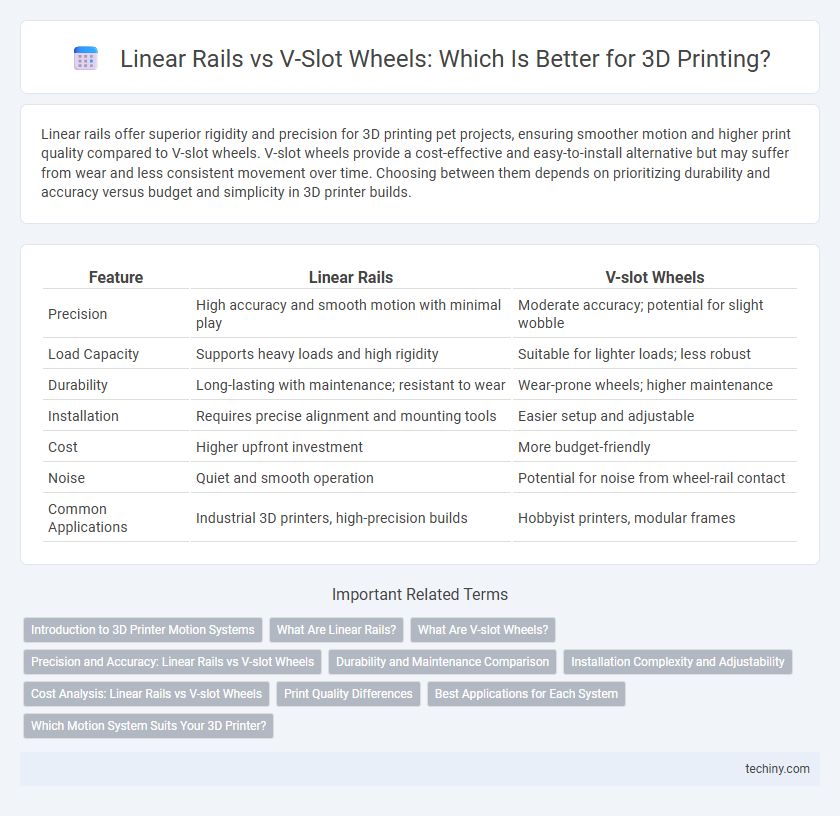Linear rails offer superior rigidity and precision for 3D printing pet projects, ensuring smoother motion and higher print quality compared to V-slot wheels. V-slot wheels provide a cost-effective and easy-to-install alternative but may suffer from wear and less consistent movement over time. Choosing between them depends on prioritizing durability and accuracy versus budget and simplicity in 3D printer builds.
Table of Comparison
| Feature | Linear Rails | V-slot Wheels |
|---|---|---|
| Precision | High accuracy and smooth motion with minimal play | Moderate accuracy; potential for slight wobble |
| Load Capacity | Supports heavy loads and high rigidity | Suitable for lighter loads; less robust |
| Durability | Long-lasting with maintenance; resistant to wear | Wear-prone wheels; higher maintenance |
| Installation | Requires precise alignment and mounting tools | Easier setup and adjustable |
| Cost | Higher upfront investment | More budget-friendly |
| Noise | Quiet and smooth operation | Potential for noise from wheel-rail contact |
| Common Applications | Industrial 3D printers, high-precision builds | Hobbyist printers, modular frames |
Introduction to 3D Printer Motion Systems
Linear rails provide high rigidity and precise linear motion, resulting in improved accuracy and reduced backlash in 3D printer motion systems. V-slot wheels offer a cost-effective and easy-to-install solution with smooth rolling on aluminum extrusion frames, ideal for lightweight or budget-friendly builds. Selecting the appropriate motion system impacts print quality, reliability, and maintenance requirements in 3D printing.
What Are Linear Rails?
Linear rails are precision motion components used in 3D printers to provide smooth, accurate, and stable linear movement along a designated axis. They consist of a rail and a bearing block that rides along it, minimizing friction and improving print quality by reducing wobble and misalignment. Compared to V-slot wheels, linear rails offer higher load capacity, enhanced rigidity, and greater repeatability, making them ideal for high-precision 3D printing applications.
What Are V-slot Wheels?
V-slot wheels are specialized components designed for 3D printer motion systems, featuring a V-shaped profile that fits precisely into corresponding aluminum extrusions. These wheels provide smooth, low-friction movement by rolling along the V-slot track, offering easy installation and maintenance compared to more complex linear rail systems. They are favored in many 3D printer builds for their balance of cost-effectiveness, durability, and reliable linear motion performance.
Precision and Accuracy: Linear Rails vs V-slot Wheels
Linear rails provide superior precision and accuracy in 3D printing due to their rigid, low-friction motion and consistent linear guidance, which reduces deflection and vibration. V-slot wheels, while cost-effective and easier to install, can introduce slight wobble and wear over time, affecting print quality. For high-precision applications, linear rails deliver enhanced repeatability and smoother motion control compared to the V-slot wheel system.
Durability and Maintenance Comparison
Linear rails offer superior durability due to their robust steel construction and preload design, which minimizes wear and maintains precision over extended use in 3D printers. V-slot wheels, made from durable plastic and running on aluminum extrusions, require more frequent maintenance such as wheel tension adjustments and periodic lubrication to prevent wobble and maintain print accuracy. While linear rails provide low-maintenance, long-lasting performance ideal for high-precision printing, V-slot wheels offer a more cost-effective solution with easier replacement but trade off longevity and stability.
Installation Complexity and Adjustability
Linear rails offer a more rigid and precise motion system but require meticulous alignment and secure mounting, increasing installation complexity compared to V-slot wheels. V-slot wheels provide simpler installation with adjustable tension through eccentric spacers, allowing easier fine-tuning and maintenance. Choosing between them depends on the desired balance between high precision and ease of assembly in 3D printer design.
Cost Analysis: Linear Rails vs V-slot Wheels
Linear rails offer superior precision and durability but come at a significantly higher initial cost compared to V-slot wheels, which are more affordable and easier to replace. V-slot wheels typically reduce maintenance expenses due to their simpler design and widespread availability of parts, making them cost-effective for hobbyists and entry-level 3D printers. When factoring in long-term use and load capacity, linear rails may justify the investment for industrial-grade 3D printing setups that demand enhanced stability and repeatability.
Print Quality Differences
Linear rails provide superior stability and precision during 3D printing, resulting in smoother layer lines and higher dimensional accuracy. V-slot wheels can introduce slight vibrations and wobble due to their rolling mechanism, potentially causing minor surface imperfections and reduced detail definition. Choosing linear rails often enhances print consistency and overall quality, especially in high-resolution applications.
Best Applications for Each System
Linear rails provide high precision and smooth motion, making them ideal for high-speed, high-accuracy 3D printing and CNC milling applications. V-slot wheels offer versatility and cost-efficiency, commonly used in desktop 3D printers and DIY projects where ease of assembly and maintenance are prioritized. For industrial-grade or large-format 3D printers, linear rails deliver superior rigidity, while V-slot wheels excel in lightweight, modular designs requiring quick adjustments.
Which Motion System Suits Your 3D Printer?
Linear rails offer high precision and rigidity, ideal for high-speed, high-accuracy 3D printing applications requiring minimal deflection. V-slot wheels provide smooth motion with ease of installation and lower cost, suited for hobbyists or budget-friendly printers prioritizing versatility. Choosing the motion system depends on your printer's performance demands, budget constraints, and maintenance preferences to optimize print quality and durability.
Linear Rails vs V-slot Wheels Infographic

 techiny.com
techiny.com